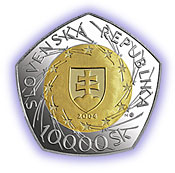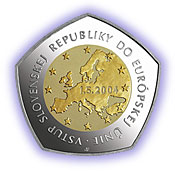-
NBS Tasks
Browse topics
- Monetary policy
- Financial market supervision
- Financial stability
- Banknotes and coins
- Payments
- Statistics
- Research
- Legislation
-
Publications
- Activity Report of the NBS Innovation Hub Annual Report Carbon Footprint Report of NBS Climate-related disclosures of NBS non-monetary policy portfolios Economic and Monetary Developments Financial Stability Report Investment Policy Statement of the National Bank of Slovakia Macroprudential Commentary
- Policy Briefs Report on the Activities of the Financial Market Supervision Unit Research Papers: Working and Occasional Papers (WP/OP) Statistical Bulletin Structural Challenges Other publications Sign up for your email notifications about publications
- About the Bank
- Media
- Frequently asked questions
-
For the public
Browse topics
- About the Bank
- Exchange rates and interest rates
- Banknotes and coins
- Payments
- Financial stability
- Financial market supervision
- Statistics
- Legislation
-
Publications
- Activity Report of the NBS Innovation Hub Annual Report Economic and Monetary Developments Financial Stability Report Macroprudential Commentary
- Report on the Activities of the Financial Market Supervision Unit Research Papers: Working and Occasional Papers (WP/OP) Statistical Bulletin Other publications Sign up for your email notifications about publications
- Frequently asked questions
- Media
- Careers
- Contact
The Slovak Republic’s accession to the European Union
10 000 Sk commemorative gold and palladium bimetal coin


The European Union is the result of the European integration process, which began after World War II. The European Community for Coal and Steel (1951), The European Community for Nuclear Energy and the European Economic Community (1957) were the forerunners of the EU. The founding countries – Belgium, France, the Netherlands, Luxembourg, Germany and Italy were gradually joined by Denmark, Ireland, Great Britain, Spain and Portugal. Finland, Austria and Sweden joined the EU after its establishment. The title European Union was adopted in February 1992, when the Treaty on the European Union was signed in Maastricht and which became effective in November 1993. The European Union is based on the principles of freedom, democracy and the respect for human rights. Its elementary goal is to support sustainable and balanced economic and social progress, especially through the establishment of a zone free of internal borders through the strengthening of economic and social cohesion and through the introduction of an economic and monetary union with a single currency.
On May 1st 2004, the largest expansion of the European Union in its history took place and the 15 member countries were joined by ten new ones – Cyprus, the Czech Republic, Estonia, Lithuania, Latvia, Hungary, Malta, Poland, Slovakia and Slovenia.
-
Coin description
Obverse:
The state shield of Slovak Republic, the year 2004, together with the circle of twelve stars – the symbol of the European Union – are depicted on a round golden blank located in the middle of the obverse of the coin. On the division of metals the is another circle of ten stars representing the accession countries. The name of the state SLOVENSKÁ REPUBLIKA is inscribed near the top edge of the coin on the palladium blank. The nominal value of Sk 10 000 is located near the bottom edge. The initial of the name of the designer Štefan Novotný, and the Kremnica Mint mark are located on the line with the year of issue on the right near the division of metals.
Reverse:
The map of Europe with the accession date of the Slovak Republic to the European Union – May 1, 2004 – is depicted on a round golden blank in the middle of the reverse of the coin. Twelve stars encircle the map. The text VSTUP SLOVENSKEJ REPUBLIKY DO EURÓPSKEJ ÚNIE (The Accession of THE Slovak Republic to the European Union) is inscribed on the outer palladium blank. The stylized initials of Ján Černaj, the designer of the reverse of the coin, are located near the bottom edge.
-
Coin details
Designer: Štefan Novotný (obverse), Ján Černaj (reverse) Material: Au 999
Pd 999Weight: 24.8828 g
Au 12.4414 g (2/5 OZ)
Pd 12.4414 g (2/5 OZ)Shape: pentagon Diameter: 40 mm (circumcircle)
23 mm – gold blankEdge: smooth Producer: Kremnica Mint (Slovak Republic) Engraver: Dalibor Schmidt Issuing volume: 7,200 in proof quality Issuing date: 3 May 2004